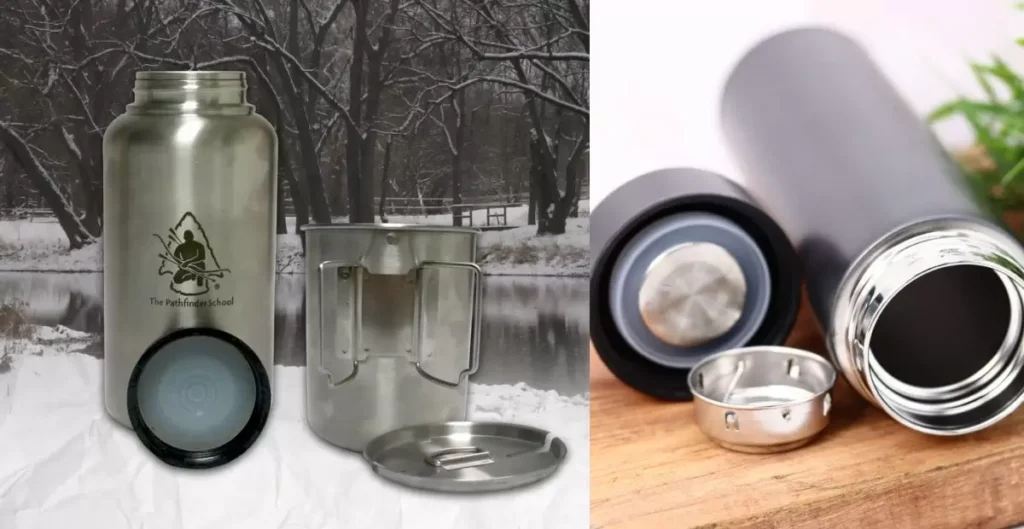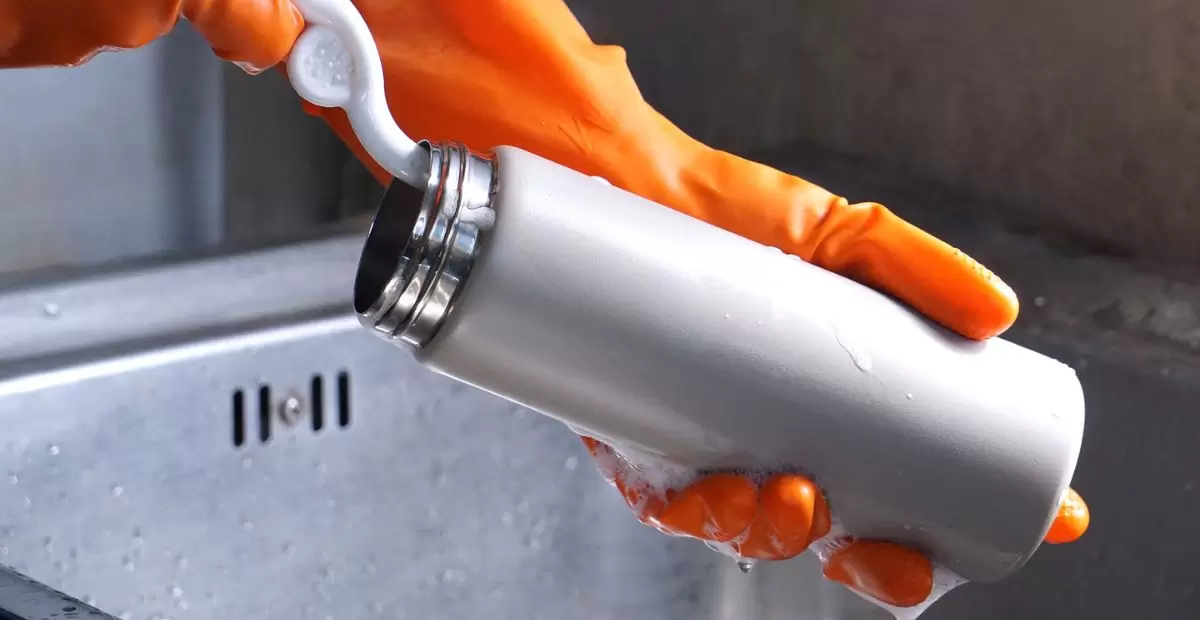A stainless steel water bottle is a portable container designed for holding liquids, typically water, and is constructed from stainless steel material. Stainless steel is chosen for its durability, resistance to corrosion, and overall robustness.
Have you ever wondered, Why Does My Stainless Steel Water Bottle Smell? It’s a question that might puzzle many users of these popular containers. Despite their sturdy and clean appearance, stainless steel water bottles can sometimes develop unpleasant odors.
The occurrence of odors in stainless steel water bottles is often linked to factors such as the buildup of bacteria, mold, or residual liquids in the bottle. Poor cleaning habits or neglecting to thoroughly clean the bottle’s nooks and crannies may contribute to the development of unpleasant smells.
Benefits of Stainless Steel over Plastic
Choosing a stainless steel water bottle over its plastic counterpart comes with a slew of benefits. Stainless steel is renowned for its durability, ensuring your bottle stands up to the wear and tear of daily use. Unlike plastic, stainless steel is resistant to cracks and breaks, providing a long-lasting and reliable hydration solution.
Stainless steel is a safer option as it doesn’t contain harmful chemicals like BPA, which can leach into your drink from plastic bottles. The material also doesn’t retain flavors or odors, ensuring that each sip from your stainless steel bottle is clean and refreshing.
Causes of Odor in Stainless Steel Water Bottles
The mystery behind the unpleasant odor in your stainless steel water bottle often revolves around a few key factors. One common culprit is the growth of bacteria or mold, especially in hard-to-reach crevices. Inadequate cleaning habits can lead to the accumulation of these microbes, resulting in a lingering smell.
Another factor is the absorption of odors from certain liquids. Strong-flavored beverages like coffee or tea, when stored for an extended period of time, can leave residual scents in the bottle. To combat these odors, regular and thorough cleaning is essential. Paying attention to neglected areas and choosing beverages wisely can help you enjoy the benefits of a stainless steel bottle without the unwanted side effect of persistent smells.
Food Particle and Drink Residue Effects
The lingering smell in your stainless steel water bottle can often be traced back to food particles and drink residue left behind. When liquids with strong odors or flavors are stored in the bottle, their remnants can adhere to the stainless steel surface. Small food particles that may not be visible to the naked eye can find their way into the nooks and crannies of the bottle, contributing to the development of unpleasant odors over time.
To prevent this, it’s crucial to rinse your bottle thoroughly after each use, paying attention to any areas that may trap residue. Regular cleaning with mild detergent and warm water can help eliminate these particles, ensuring your stainless steel water bottle stays fresh and odor-free.
Growth of Mold and Bacteria
One common reason your stainless steel water bottle might emit unpleasant odors is the growth of mold and bacteria. When moisture is trapped inside the bottle, especially in hard-to-reach areas, it creates an ideal environment for these microorganisms to thrive. Mold and bacteria can multiply rapidly, leading to a noticeable smell emanating from your bottle.
To prevent this, make sure to thoroughly clean and dry all parts of your stainless steel water bottle after each use. Regular maintenance, including washing with mild soap and using a bottle brush to reach crevices, can significantly reduce the risk of mold and bacteria growth.
Impacts of Infrequent Cleaning
Infrequent cleaning of your stainless steel water bottle can have a direct impact on its overall freshness. Over time, residual liquids and particles can accumulate in the bottle, creating an environment that fosters the growth of bacteria and contributes to unpleasant smells. The longer you go without cleaning, the more challenging it becomes to eliminate these odors.
Establishing a routine of regular cleaning, ideally after each use, helps prevent the buildup of contaminants and ensures that your stainless steel water bottle remains odor-free. By adopting simple habits like rinsing with warm water and mild soap, you can maintain a clean and fresh bottle for your hydration needs.
Role of Scratches and Dents
The role of scratches and dents in your stainless steel water bottle cannot be overlooked when addressing potential odors. Scratches, even if minor, can create tiny crevices where bacteria and mold can settle, making it challenging to eliminate odors through regular cleaning. Dents may also impact the bottle’s structure, making it harder to reach and clean certain areas.
To mitigate this issue, promptly address any scratches by smoothing them out if possible and clean the affected area thoroughly. Regularly inspect your bottle for dents and scratches, and take preventive measures to ensure they don’t compromise the hygiene of your stainless steel water bottle.
Getting Rid of Stainless Odors

If you find yourself asking, Why Does My Stainless Steel Water Bottle Smell? fret not, as there are simple ways to banish those unwelcome odors. One effective method is to create a solution of equal parts water and white vinegar. Pour the mixture into your stainless steel bottle, let it sit for a few hours, and then give it a thorough rinse.
The acidity of the vinegar helps eliminate bacteria and neutralize odors, leaving your bottle fresh. Another quick fix involves using baking soda. Sprinkle a teaspoon or two into the bottle, add warm water, and shake it vigorously. Let it sit for a while before rinsing, and voilà, the baking soda absorbs lingering smells, giving your stainless steel bottle a clean slate.
Cleaning Methods to Prevent Smells
Preventing odors in your stainless steel water bottle is as crucial as getting rid of them. Establishing a routine cleaning schedule is key to maintaining a fresh-smelling bottle. Wash your bottle with mild dish soap and warm water after each use, paying extra attention to the cap and threads. For a deeper clean, use a bottle brush to scrub hard-to-reach areas.
Enhance the radiance of your stainless steel water bottle and prevent issues like stainless steel turning rainbow by utilizing a bottle-cleaning tablet. Simply drop it into your bottle with water, and let it fizz away impurities. Refer to the table below for a quick summary of effective cleaning methods for maintaining the pristine appearance of stainless steel water bottles.
| Cleaning Method | Instructions |
| Vinegar Solution | Mix equal parts water and white vinegar, soak, rinse. |
| Baking Soda Shake | Sprinkle baking soda, add warm water, shake, then rinse. |
| Routine Dish Soap Wash | Wash with mild dish soap and warm water after each use. |
| Bottle Brush Scrub | Use a bottle brush to reach and scrub hard-to-clean areas. |
| Cleaning Tablet | Drop a bottle-cleaning tablet in water, let it fizz, then rinse. |
Incorporating these cleaning methods into your routine will help keep your stainless steel water bottle smelling fresh and ready for your next hydration adventure.
Safely Disinfecting Stubborn Odors
When faced with stubborn odors in your stainless steel water bottle, it’s crucial to know how to safely disinfect it. Start by thoroughly washing the bottle with mild soap and warm water. Pay extra attention to the cap, mouthpiece, and any hidden crevices where bacteria might linger. For a more potent disinfectant, a mixture of equal parts water and white vinegar can be highly effective.
Let the solution sit in the bottle for a few hours before rinsing it thoroughly. Baking soda is another natural deodorizer that works wonders. Just sprinkle some inside, add water, and shake vigorously before rinsing. These methods not only eliminate odors but also ensure your bottle is safe and ready for use.
Selecting Quality Crafted Bottles
When it comes to stainless steel water bottles, not all are created equal. Choosing a quality-crafted bottle can make a significant difference in odor prevention and overall longevity. Opt for bottles made from high-grade stainless steel, typically labeled as 18/8 or 304, as these alloys are resistant to corrosion and less likely to retain odors.
Check for bottles with wide mouths, making them easier to clean thoroughly. Some bottles even come with removable gaskets in the caps, allowing you to access every nook and cranny for a comprehensive clean. Investing in a reputable brand known for durable and odor-resistant bottles can ensure that you enjoy a reliable and odor-free hydration experience.
FAQs
How can I get rid of the smell in my stainless steel water bottle?
To eliminate odors, wash your bottle thoroughly with mild soap and water, or use a mixture of equal parts water and white vinegar, letting it sit before rinsing. Baking soda is also effective; sprinkle it inside, shake, and rinse.
Why does my stainless steel water bottle develop odors?
Persistent odors can result from bacteria, mold, or residual liquids in the bottle. Regular cleaning, especially in hidden areas, and avoiding strong-smelling beverages can help prevent unpleasant smells.
What should I look for when selecting a quality stainless steel water bottle?
Choose bottles made from high-grade stainless steel (18/8 or 304) for corrosion resistance. Opt for wide-mouth designs for easy cleaning, and consider brands known for durable, odor-resistant bottles.
Conclusion
To keep a stainless steel water bottle smell- and odor-free, consistent cleaning habits are key. Take a moment to clean not only the visible parts but also the less obvious areas where bacteria might hide. A mixture of water and white vinegar or a sprinkle of baking soda can be powerful allies in tackling stubborn odors.
Choosing a quality-crafted bottle also plays a crucial role in the prevention of odors. Opt for those made from high-quality stainless steel, and pay attention to design features like wide mouths and removable gaskets for thorough cleaning. Investing in a reputable brand ensures that your bottle is not only durable but also less prone to retaining odors, contributing to a consistently pleasant drinking experience.
